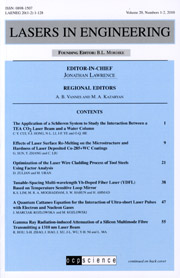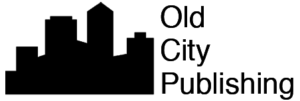 LIE Home · Issue Contents · Editorial Board
LIE Home · Issue Contents · Editorial Board
Subscription Info · Contributor Notes · Online Submissions · Call for Papers · Recommend
Submission of Manuscripts
Please submit your manuscript to:
Bekir S. Yilbas
Mechanical Engineering
King Fahd University of Petroleum and Minerals (KFUPM)
Box 1913
Dhahran 31261,
Saudi Arabia
email
Lasers in Engineering strongly encourages the electronic submission of manuscripts. Each manuscript should be sent as a single complete attachment with a cover email indicating that the article is being submitted for publication in Lasers in Engineering. The attachment should be in Microsoft Word format (preferably Word 97 or later). Please also include a PDF file with the fonts embedded.
Manuscripts, where appropriate, should contain these sections in this order: Title, Author By-Line, Abstract, Keywords, Introduction, Main Text, Conclusions, Acknowledgments, Nomenclature, and References. In addition, the Main Text should be broken into several appropriate sections such as Experimental Apparatus, Results, Discussion, Conclusion, Future Directions, etc.
The manuscript should consist of type and equations only, with all tables, line drawings, and photographs grouped together as artwork at the end of the text.
Submission of a paper to Lasers in Engineering implies that it has not been published in or submitted to another journal. Selected papers from conference proceedings will be accepted for publication by prior arrangement with conference organizers. Upon acceptance, the publisher acquires the copyright for unlimited worldwide distribution including an electronic format.
Guidelines for the Submission of Text
Submissions should be made as Microsoft Word documents. The manuscript and references should be double-spaced, presented in an easily readable, standard font and size (such as 10 or 12 pt. Times New Roman or Arial). All pages should be numbered. All manuscripts must be submitted in English; American or British spelling may be used.
Length: Lasers in Engineering will consider papers of any length. Generally, the text of the manuscript should run 15 to 40 double-spaced pages, plus artwork grouped at the end.
Title: The title of the paper should clearly indicate the scope and findings of the paper and should provide an accurate indication of the contents when searched by computerized methods. An abbreviated title of a maximum of 35 characters should be provided as well.
Authors: The names of authors should be given in full (first name, initial(s), last name) followed by his or her department, institution and address including postal code and country. The author to whom correspondence should be directed should be indicated in the cover letter. For the corresponding author, telephone and fax numbers and e-mail address should be provided as well.
Abstract: Manuscripts should include an abstract of 100-150 words summarizing the significant findings.
Keywords: Six to twelve keywords or phrases should be supplied to aid in indexing the article.
Text headings: Headings should be set flush left and the text should begin on the next line. For example:
first-level HEADING (bold, all caps.)
second-level Heading (bold, upper case and lower case characters)
third level Heading: (underscore:, upper case and lower case characters)
Nomenclature: A nomenclature section defining all symbols used should be included at the end of the paper. Please indicate S.I. units.
Tables: Tables should be numbered consecutively and include a clear descriptive caption at the top. Avoid the use of structural formulas in the body of tables. Table footnotes should be given a footnote symbol as explained in the Footnotes section, proceeding by row rather than by column order.
References: References should be indicated in the text by consecutive Arabic numbers in brackets. The full list should be collected at the end of the paper in numerical order. All references in the list should be cited within the text, and vice versa. References should be numbered by the order in which they appear in the text. Listed references should be complete in all details, including article titles in journals. All authors on each paper should be cited; “et al.” is not sufficient. Journal title abbreviations should conform to Mathematical Reviews Index style.
Examples
Journal article:
[1] Last name one, first initial., Last name two, first initial. (year). Title of article. Journal Title, volume, pages.
Book:
[2] Last name, first initial. (year). Book Title (edition). City: Publisher.
Stand-alone Web document
[3] Last name, first initial. (year). List of authoring systems. Retrieved date, from http://www.website.com/.
Mention of figures and tables within text: When referring to figures, tables and other elements within the text, always call the element by its full name (for example: “See Table 1”, “Figure 1 illustrates…”, “Refer to Scheme 1”). Do not use ambiguous phraseologies (for example: “1 illustrates…”) that do not clearly denote the element being referred to.
Footnotes: Authors are encouraged to minimize the use of footnotes. A footnote may include the designation of a corresponding author of the paper, current address information for an author (if different from that shown in the affiliation), and traditional footnote content. Information concerning grant support of research should appear in a separate Acknowledgments section at the end of the paper, not in a footnote. Acknowledgments of the assistance of colleagues or similar notes of appreciation also properly belong in an Acknowledgments section, not in footnotes.
Footnotes should be indicated in the text by the following symbols: *(asterisk or star), † (dagger), ‡ (double dagger), ¶ (paragraph mark), § (section mark), || (parallels), # (number sign). Do not use numerals for footnote call-outs, as they may be mistaken for bibliographical reference call-outs or exponents. Type each footnote at the bottom of the typescript page on which its text call-out appears. Footnotes within a table should be indicated by the same symbols listed above. Reinitialize symbol sequence within tables. Type footnotes to a table directly beneath the table.
Mathematical Equations: Wherever possible, mathematical equations should be entered in the Microsoft Word document, with unusual or ambiguous symbols identified in the margin where they first occur. Alternatively, equations may be typewritten on a separate page, with their designated positions specified in the text.
Units: Please use S.I. (metric) units. Where useful, inch/pound equivalents may be included in parentheses.
Specifications for the Submission of Figures and Artwork
Figures may be provided as either original high quality hard copies or as separate electronic files.
If supplied as hard copy, photos should be high quality, glossy, original prints of maximum contrast. Line art should be original, camera-ready copy on white paper or clear transparency of a standard for direct reproduction. Film negatives are not acceptable.
Electronic images supplied separately should be saved as EPS, TIFF, JPEG or BMP files. It is very important that all electronic images be provided as high-resolution files. Photographic images (black & white or color) should be saved at a resolution of 300 dpi minimum. Line art should be saved between 600 and 1200 dpi.
Full captions and photo credits (if necessary) should be provided for each photo and figure. All images should be clearly labeled as to figure number. Top should be indicated if it is not immediately apparent.
Whenever the use of color is an integral part of the research, or where the work is generated in color, the journal will publish the color illustrations as color plates in the back of the issue without charge to the authors. Reprints in color will carry a surcharge. Please write to the Editor for details.
For artwork originally published elsewhere, it is the author’s responsibility to obtain written permission to reprint.
Proofs
The corresponding author will receive proofs of the typeset article via e-mail as a PDF file. Please ensure that an e-mail address at which PDF attachment files may be received is provided.
Reprints
The corresponding author will receive a PDF file of the finalized article for free use. Additional reprints may be ordered by completing the appropriate form supplied with the proofs.
Page Charges
There are no page charges to individuals or institutions for contributions to Lasers in Engineering.
